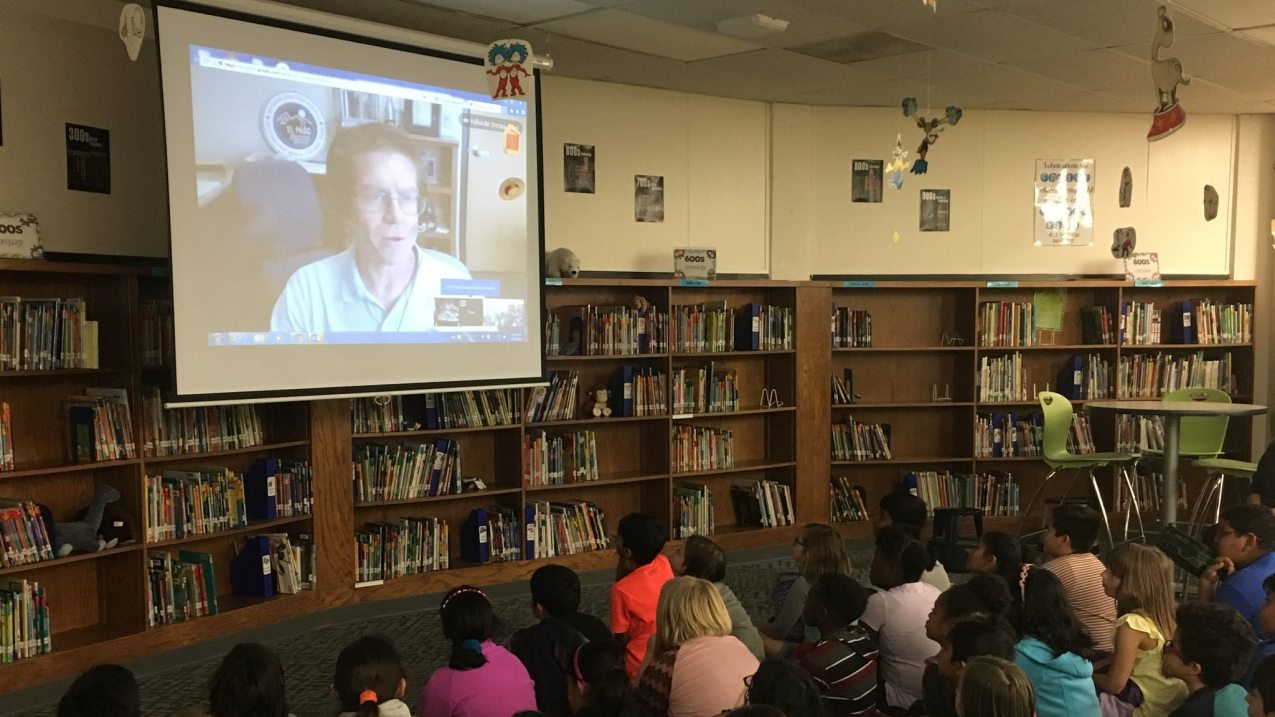Virtual school outreach lets students chat directly with weather experts.
National Weather Service experts use all the tools at their disposal to protect life and property. Whether that’s flying an airplane into the eye of a hurricane or using Facebook Live to share safety information about an emergency as it unfolds, they get the public the information they need when they need it. Using this same approach, a group of meteorologists turned to technology to reach students and teachers in a new format.

Seated in a school library, third-grade students from Illinois ask National Weather Service forecaster Tim Brice their weather questions via video conference. (Image credit: Joni Harris/NOAA)
In a modern take on the classroom visit, the National Weather Service’s Virtual School Outreach team uses video conferencing to teach students about the weather. This approach allows NWS to supplement traditional school outreach when in-person events simply aren’t an option.
“Hey, we can do this with the weather."
Tim Brice, meteorologist in El Paso, Texas, had the idea to try visiting classrooms via video after seeing other organizations successfully using Skype and Google Hangouts to connect with kids. Brice is an education enthusiast and self-described “techno-geek.” After seeing virtual education in action, he thought, “Hey, we can do this with the weather. We can leverage this as a technology.”
For the El Paso Weather Forecast Office, a virtual option had its appeal; in their vast area of responsibility, it can take three hours just to drive to a school for an in-person presentation. Time-in-transit limited the number of students the forecasters could work with, even for dedicated educators like Brice. But reaching students by video meant that he could fit a school visit into a free hour in his schedule.
The idea took off, first in the El Paso area, then around the country, and eventually even internationally. Within a year, Brice had established a network of experts who were ready to jump on a video call to chat with students about the weather.
So, how does it work?
To request a video call, educators can visit the National Weather Service National School Outreach program web page. The team will discuss priorities, topics, and any special requests. They will set up a time and reach out to the local forecast office to see if they can participate. After that, any of the nearly 60 forecasters on the Virtual School Outreach team can join in if they are free for the meeting. This enables students to have in-depth conversations with meteorologists about their local weather — “even if we’re a thousand miles away,” said Brice.
“Doing [school outreach] online is great, because you can reach so many more people,” said Sarah Atkins, a meteorologist in Kansas City and a member of the Virtual School Outreach team. “It doesn’t beat being there in person, but it’s certainly better than nothing.”
Tailored to the classroom
Based on teacher feedback, “better than nothing” might be an understatement. "Your presentation fits perfectly into our current science and ELA curriculums!" said Erin Long, third-grade teacher at Butler Acres Elementary School in Kelso, Washington. Jason Borawski, Technology Integration Specialist at J.P. Cast Middle School in Flemington, New Jersey, added, "This was perfect! The teacher actually said you were using some of the same visuals he was using so reinforcement was spot-on."
With the help of the video chats, the National Weather Service can supplement or fill in the gaps on weather concepts in the classroom. Brice worked with a teacher to develop a weather basics presentation that covered the main points students are tested on in Texas. Over time, the team has refined the presentation so that it can be adapted and used throughout the country.
Teachers can request a special topic or choose between three main presentations formats: weather basics, severe weather, or ask-a-meteorologist. The team does their best to tailor each presentation to the students’ region, even including pictures from their state whenever possible.
"We are very grateful to teachers for allowing us in their classrooms,” said Atkins. “Educating students about weather and weather safety is important in helping keep people safe."
Get involved
Since 2017, the Virtual School Outreach team offered over 187 presentations, reaching 7,800 students across the United States, Mexico, the United Kingdom, Canada, and Argentina.
Are you interested in setting up a NWS hangout for a classroom? To sign up, visit the National Weather Service National School Outreach program web page and email the team with the following information:
- Name of the point of contact for the talk
- You school name and location (city, state)
- Grade level
- Type of presentation you want (basic weather talk, severe weather, ask-a-meteorologist, other)



